We asked guide Greg Smith about his photos of iconic Alaskan mammals, how he finds them, and how they fit into the stunning Denali landscape. Here are his responses.
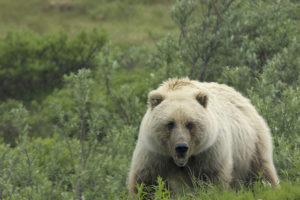
Naturalist Journeys’ guide, Greg Smith, is not only a fantastic guide, but also an incredible photographer; we are lucky to have him on our team.
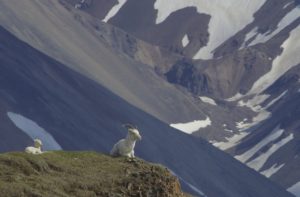
Dall Sheep
Wolf predation was thought to be the reason that Alaska’s Dall Sheep numbers went through a steep decline in the 1930s. Pioneer wildlife researcher Adolf Murie was brought in to study the situation, disproving the wolf theory. His landmark research on wolf-sheep interactions used an ecological approach that strongly influenced the park service’s future wildlife management. Our tours enjoy a picnic dinner in Denali at his former cabin, often with a view of this inspiring species. For many, this member of the Bovid family embodies the wilderness spirit of the park.
Greg’s Take: One of the things I always look for while traversing Alaska is barren, grass covered mountain terrain. This is where Dall Sheep ewes raise their lambs at the early stages of life. With sweeping 360-degree views, it would be a challenge for any predator to get close enough to take a lamb.
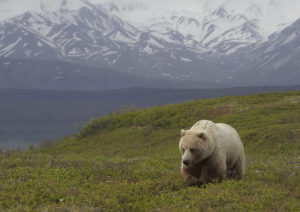
Grizzly Bear
Perhaps the most iconic of Alaskan mammals, it is such a thrill when we spot a Grizzly Bear. Summer is short in the north country, and Grizzly Bears actively feed throughout the day — particularly sows with young cubs. In August ripe berries provide sweet energy but take time to harvest; we have ample chances to observe them — sometimes with a half-dozen or more sightings in a day!
Greg’s Take: One of the best places in Denali National Park to look for Grizzly Bears is along one of the mountain passes we cross to get to North Face Lodge. Denali’s broad valleys narrow down to constricted passes that most all of the wildlife use to get from one feeding location to another. Spend time in one of the passes (Thorofare, Stony Hill, and Sable) and you will find Grizzly Bears making their transit.
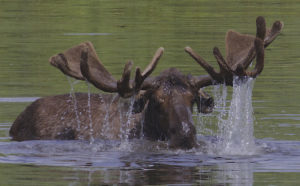
Moose
Also iconic, the Alaska-Yukon Moose is the largest race of Moose and is just stunning to spot. Typically we see them in Denali National Park and feeding in the verdant ponds and lakes we pass en route to Kenai Fjords National Park and Seward. We have large bulls and mothers with young calves right in the wildlife corridors like Earthquake Park and its coastal trail in Anchorage.
Greg’s Take: For Moose, it is all about foraging on willows to get them through winter, and for willows, it is all about water. When all that ice melts, it provides access for the Moose to underwater vegetation, a summertime delicacy. I look for ponds with some willows along the edge during the crepuscular hours to find these giants.
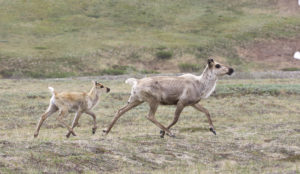
Caribou
Did you know? Both male and female Caribou grow antlers. We watch for herds of these Alaskan mammals as we explore Denali.
Greg’s Take: These are barren-ground Caribou, which are always out feeding in the open. For years it was always a distant view, but with the recent trend of dwindling wolf numbers (due to hunting pressure adjacent to the park boundaries in some areas), Caribou are now seen much closer to Denali National Park’s travel ways. If there are still patches of snow on the ground, look for Caribou bedded down to keep cool and to keep the insects at bay.

Gray Wolf
What a thrill to see a wolf! Last year Greg and his group watched as one dragged a Caribou leg off into the distance.
Greg’s Take: Sporadic at best, it really is a challenge to pick the “gray” and lighter-colored individuals out in brush and willows. But if there is a black in the pack, it is so much easier. Alaska has a significant number of braided rivers, all fed by glaciers. As with most animals, these unvegetated river beds are a wildlife highway. I am always scanning the riverbeds looking for movement and wolves.

Red Fox
Common but beautiful, this Alaskan mammal often makes for interesting photographs.
Greg’s Take: Certainly the most common mammalian predator in Denali National Park, and that is because they are the most adaptable. Feeding on birds, rodents, and some vegetation, I am always looking for Foxes foraging where people are located. Invariably, people drop bits of food, which are an attractant to the Foxes’ prey. Look for the different color phases of the Red Fox in open areas along park roads near public buildings.
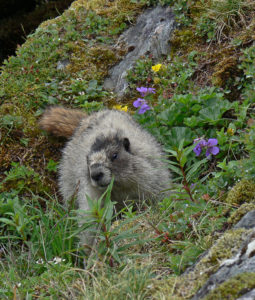
Hoary Marmot
Did you know that Whistler Mountain (in Canada) was named after these marmots? Sometimes called “whistle pigs” the Hoary Marmot lets out a high-pitched warning whistle.
Greg’s Take: Whenever I see patches of rocks near alpine meadows, I always look for small, but odd shapes breaking the outline of the rocks. These jumbles of stone are both home and lookout vantage points that Hoary Marmots use to spot predators. The Hoary (silvery) Marmot can be very curious when movement doesn’t mimic what is usually found in their habitat.

Arctic Ground Squirrel
The largest of North America’s ground squirrels, we see these Alaskan mammals in abundance.
Greg’s Take: These all-too-cute iconic mammals are nicknamed the “bear burrito” since Grizzly Bears are always digging up their burrows in search of a snack. Heavy breeding is what keeps the Arctic Ground Squirrels’ population numbers up, as well as their ability to move quickly. The sides of roads and areas that look like there are small, mowed patches in alpine tundra are the best locations to observe and photograph this ubiquitous species.
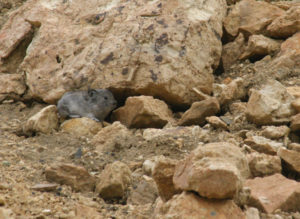
Collared Pika
Common, but tricky to see due to their size, the Collared Pika keeps very busy harvesting and storing vegetation for the winter (they don’t hibernate!).
Greg’s Take: Collared Pika would be a life mammal for me. I know Naturalist Journeys‘ owner and my fellow guide Peg Abbott observed one close up when the North Face Lodge bus pulled over to allow another vehicle to pass — there it was at eye level in the rock cliff! She caught this shot with a small point and shoot camera!
Lynx
Elusive (enough so that we don’t have an image) and elegant, a Lynx would be a lucky spot for our groups.
Greg’s Take: Lynx would also be a life mammal, but I will keep trying on this one for sure! Peg’s one up on me here; her group found one sleeping on the ridge above the Murie Cabin during the picnic dinner stop on a trip into North Face a few years ago. It was so well-fed on snowshoe hares (that year had a high population), it only awakened when a Black-billed Magpie landed nearby, despite long scope views by our group!
Each year, Naturalist Journeys typically offers two Alaska tours — one in June and the other in August. Email us at info@naturalistjourneys.com or give us a call today to learn more! 866-900-1146

